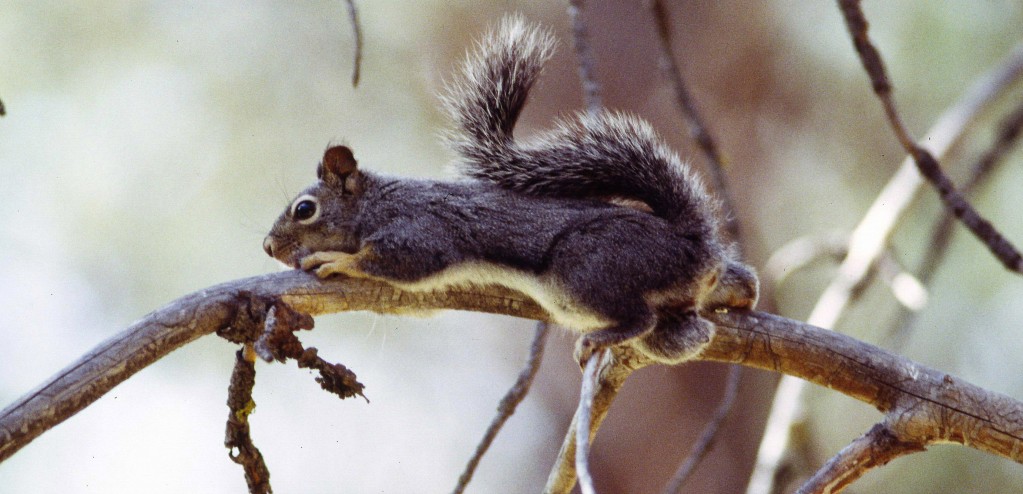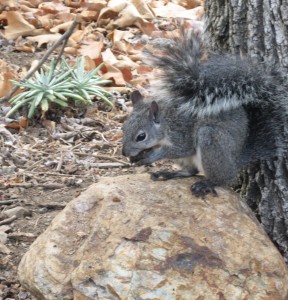Rambling LA: Native gray
Posted on | September 29, 2009 | 2 Comments
By Ilsa Setziol
Who hasn’t watched their backyard squirrels scurry along power lines, spiral up and down tree trunks, whip their tails and holler “chkk-chkk-chkk” at trespassing scrub jays?
Now that autumn trees are full of acorns, the antics are in overdrive.
Surprisingly, though, the squirrels leaping from bough to bough in urban Los Angeles aren’t native.
Before urbanization, trees were far less common in the Los Angeles basin. Ground squirrels burrowed into the earth, but the native arboreal squirrel lived in mountainous areas.
This native tree squirrel is the western gray (Sciurus griseus), whose distinctive features include bushy grey tails and white bellies.
By comparison, the type of animal hanging from the birdfeeder by its toes in so many of our yards is most likely an eastern fox squirrel (Sciurus niger). Originally native to the eastern US and now endemic to the West, these can be identified by telltale yellow bellies.
Both the eastern fox and western gray squirrel are natural born Tarzans. According to Jim Dines, collections manager for mammalogy at the LA County Natural History Museum, the key to the acrobatics that makes squirrel-watching better than a trip to the circus is found in their ankle joints. These allow tree squirrels to rotate their hind feet sideways, even backwards. “It helps them grab onto things in ways other animals can’t,” says Jim Dines, adding, “They also have long toes and sharp claws.”
Until about five years ago, western squirrels could still be found in several suburban Southern California communities. But then, according to residents surveyed by Cal State Los Angeles researchers, the eastern fox squirrels moved in.
It’s fairly well documented that at the turn of the 20th Century, Civil War vets toted eastern fox squirrels with them when they retired to the Sawtelle Disabled Veterans Home in West Los Angeles. “They probably enjoyed having them as pets or as animals to remind them of home,” says Cal State Los Angeles biologist Alan Muchlinksi, “and I’m sure they were using them for a food supply. As the story goes, the new commandant came in and said, ‘No more pets,’ so they released some of them.”
Urbanization did not faze the eastern fox squirrels. The lawns and fruit tree resembled the habitat in which they evolved–spacious hardwood forests, adjacent to prairies and savannas where they’d bury their nuts.
Research by Muchlinski’s then graduate student Julie L. King found eastern squirrels eat a much broader diet than the natives, including seeds and flowers of non-natives such as eucalyptus and Chinese elm. They also nest in a wider variety of trees. “The fox squirrel is a more generalist type of species,” says Muchlinski, “and generalists tend to do well when introduced to a new habitat that’s favorable to them.”
Are eastern fox squirrels responsible for the decline of native squirrels? It’s a complicated question that Muchlinksi and his students are still studying. In some places, such as Cal Poly Pomona, fox squirrels seem to have pushed out the grays. In others, the two species are coexisting.
One such spot is San Dimas Canyon County Park. Earlier this year, Muchlinski and I strolled there under a canopy of coast live oaks and eucalyptus. There are far fewer native squirrels here, but they’re holding their ground. Indeed, when the two species do fight—essentially shouting matches with furious tail swishing—no blood is shed and the westerners usually succeed in chasing off the easterners.
Muchlinksi pointed out how the mature trees were sufficiently big and close enough to form what’s called a closed canopy. “So a squirrel that goes up this particular tree here can go to the next tree and the next without coming to the ground,” he noted. “That does seem to be very important for the native gray squirrel.”
Fox squirrels, as a glimpse at urban road-kill shows, are not so picky. It’s likely the natives evolved their tree-bound lifestyle to avoid predation. Muchlinski says for them the type of tree seems to matters more, too: gray squirrels appear to favor evergreens that provide year-round cover. Lest you think the grays are wimps, bear in mind that they usually thrive in wilder areas where fox squirrels fear to tread.
You’d think the fox squirrel’s more brazen behavior would decrease its advantage, but it produces two litters of babies a year to the gray squirrel’s usual one.
Western gray squirrels have already been designated a threatened species in Washington state because of habitat loss, and are also declining in Oregon. Muchlinksi says their situation locally is precarious: “In some habitats where the two species are coexisting, the native is just barely hanging on. There may be a couple of breeding pairs. When you get to that situation, any disease that comes along, any random acts of predation, or a fire could quickly wipe out the gray squirrel.”
When Muchlinski and his students have finished their study, they’ll make recommendations to Parks and Recreation staff and other municipal officials. “By producing certain types of habitat in urban and suburban areas, we can have places in which both eastern fox squirrels and western gray squirrels can coexist.”
Copyright (c) Ilsa Setziol. All rights reserved.
You can contribute to Muchlinski’s study by reporting where you’ve seen western gray squirrels. Here’s how.
Could a stewpot could be a legal solution to burgeoning fox squirrel populations? Click here.
Here is a good generalist fact sheet on Western gray squirrels from Oregon State University cooperative extension. A taxonomical treatment from the American Society of Mammalogists may be found here.
Ilsa Setziol’s home blog is RamblingLA. Last but not least, here is Ilsa’s choice of squirrel recordings on YouTube:
Comments
2 Responses to “Rambling LA: Native gray”
Leave a Reply






October 14th, 2009 @ 8:11 pm
[…] human development proliferated, so did introduced species such as the eastern fox squirrel, rock doves–a.k.a pigeons—and possums. “We’ve have garbage all over the city, squirrels eat […]
January 6th, 2010 @ 7:21 pm
Thanks for the post.. I really enjoy reading it and I learn a lot of things..